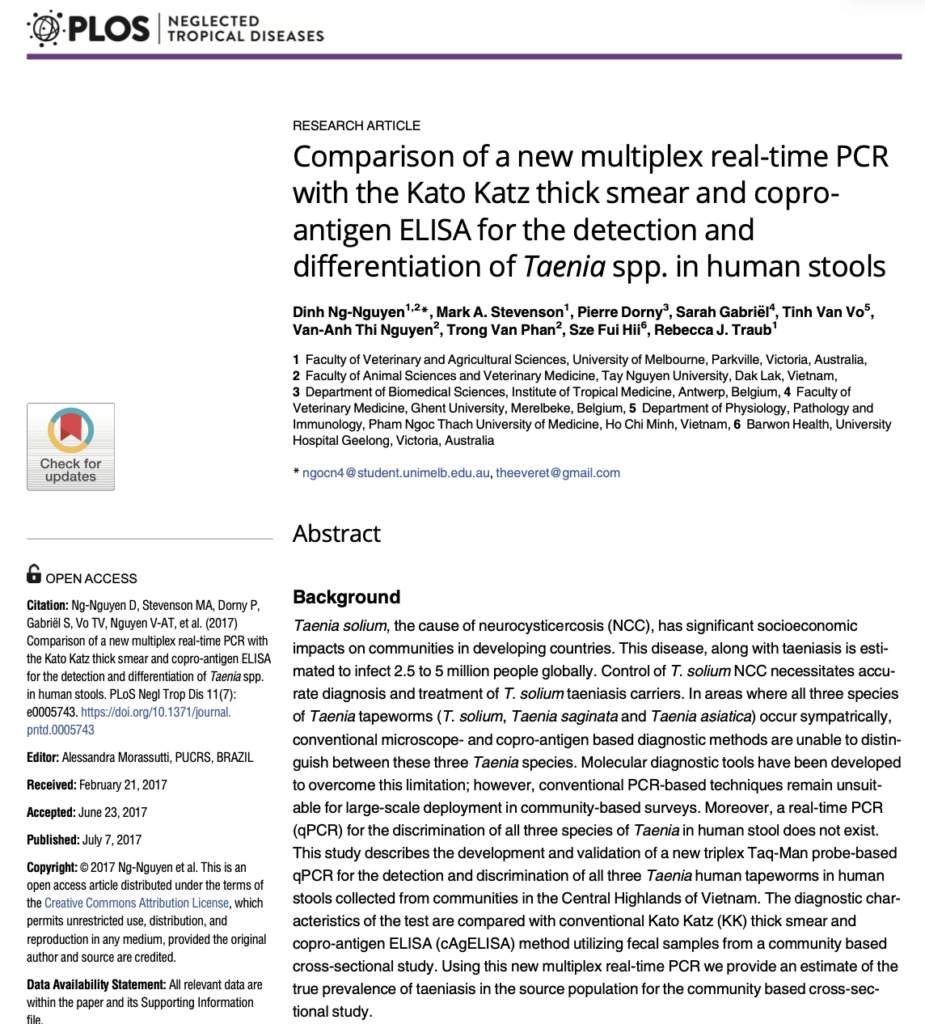Comparison of a new multiplex real-time PCR with the Kato Katz thick smear and copro- antigen ELISA for the detection and differentiation of Taenia spp. in human stools
Dinh Ng-Nguyen, Mark A. Stevenson, Pierre Dorny, Sarah Gabriel, Tinh Van Vo, Van-Anh Thi Nguyen, Trong Van Phan, Sze Fui Hii, Rebecca J. Traub
Faculty of Veterinary and Agricultural Sciences, University of Melbourne, Parkville, Victoria, Australia, Faculty of Animal Sciences and Veterinary Medicine, Tay Nguyen University, Dak Lak, Vietnam, Department of Biomedical Sciences, Institute of Tropical Medicine, Antwerp, Belgium, Faculty of Veterinary Medicine, Ghent University, Merelbeke, Belgium, Department of Physiology, Pathology and Immunology, Pham Ngoc Thach University of Medicine, Ho Chi Minh, Vietnam, Barwon Health, University Hospital Geelong, Victoria, Australia|2017|PLoS ONE|11:7: e0005743. https://doi.org/10.1371/journal. pntd.0005743
Human taeniid tapeworms comprise of three Taenia species, Taenia solium (T. solium), Taenia saginata (T. saginata) and Taenia asiatica (T. asiatica) that are transmitted by the consumption of cysticerci in raw or undercooked pork (T. solium, T asiatica) and beef (T. saginata). Consumption of T. solium eggs can also cause neurocysticercosis by the formation of cysticerci in the brain and is prominent in many resource-poor communities. Molecular diagnostic tests using conventional PCR have been developed to accurately diagnosis and distinguish between three Taenia species (T. solium, T. saginata and T. asiatica). However, conventional PCR is not appropriate for large-scale deployment. In this study, the first qPCR assay was developed for the detection and differentiation of all three species of Taenia in human stool. The assay was designed to target the internal transcribed spacer (ITS-1) gene of T. solium and the cytochrome oxidase subunit I (COXI) gene of T. saginata and T. asiatica). The assay was validated and compared with the conventional testing methods of Taenia, Kato Katz thick smear and copro-antigen ELISA. Sensitivities of 94%, 82% and 0.52% and specificities of 98%, 92% and 99% were found for the qPCR, copro-antigen ELISA and Kato Katz thick smear, respectively. This novel Taenia multiplex assay provides a simple and economical solution for detection of the three Taenia species. The low cost and high sensitivity allow application in under resourced countries where neurocysticercosis is endemic to.
